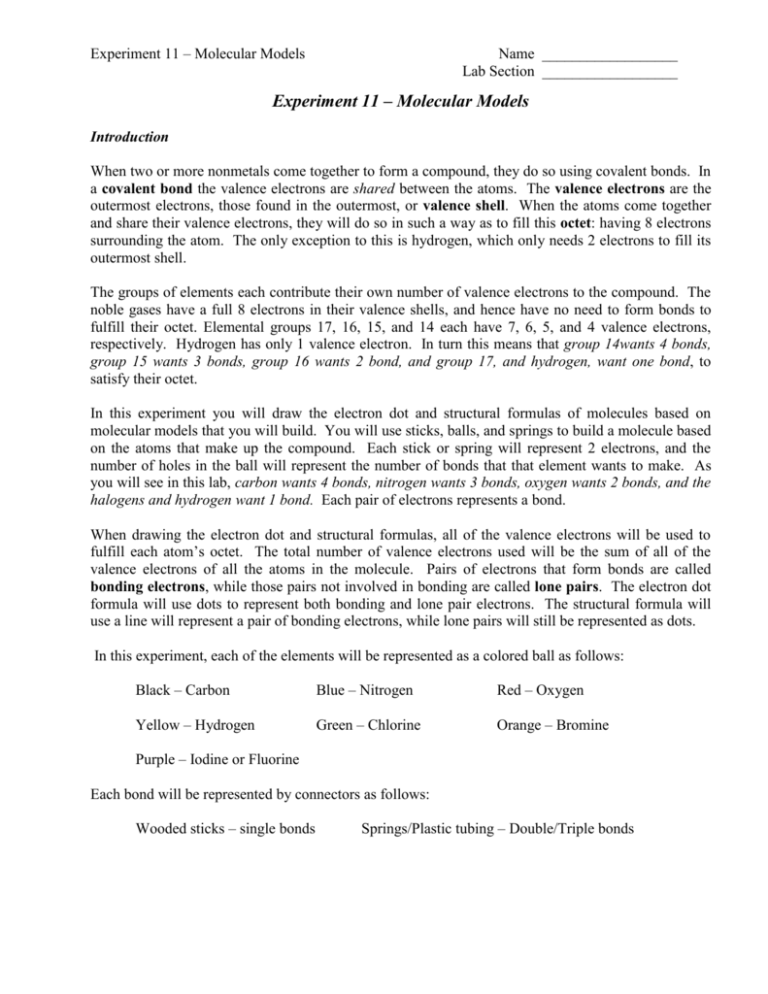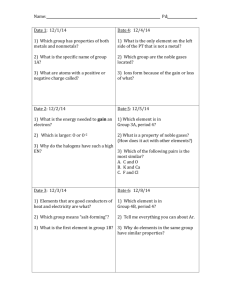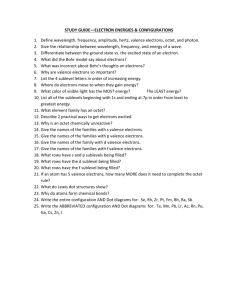Experiment 11 - Molecular Models
advertisement

Experiment 11 – Molecular Models Name __________________ Lab Section __________________ Experiment 11 – Molecular Models Introduction When two or more nonmetals come together to form a compound, they do so using covalent bonds. In a covalent bond the valence electrons are shared between the atoms. The valence electrons are the outermost electrons, those found in the outermost, or valence shell. When the atoms come together and share their valence electrons, they will do so in such a way as to fill this octet: having 8 electrons surrounding the atom. The only exception to this is hydrogen, which only needs 2 electrons to fill its outermost shell. The groups of elements each contribute their own number of valence electrons to the compound. The noble gases have a full 8 electrons in their valence shells, and hence have no need to form bonds to fulfill their octet. Elemental groups 17, 16, 15, and 14 each have 7, 6, 5, and 4 valence electrons, respectively. Hydrogen has only 1 valence electron. In turn this means that group 14wants 4 bonds, group 15 wants 3 bonds, group 16 wants 2 bond, and group 17, and hydrogen, want one bond, to satisfy their octet. In this experiment you will draw the electron dot and structural formulas of molecules based on molecular models that you will build. You will use sticks, balls, and springs to build a molecule based on the atoms that make up the compound. Each stick or spring will represent 2 electrons, and the number of holes in the ball will represent the number of bonds that that element wants to make. As you will see in this lab, carbon wants 4 bonds, nitrogen wants 3 bonds, oxygen wants 2 bonds, and the halogens and hydrogen want 1 bond. Each pair of electrons represents a bond. When drawing the electron dot and structural formulas, all of the valence electrons will be used to fulfill each atom’s octet. The total number of valence electrons used will be the sum of all of the valence electrons of all the atoms in the molecule. Pairs of electrons that form bonds are called bonding electrons, while those pairs not involved in bonding are called lone pairs. The electron dot formula will use dots to represent both bonding and lone pair electrons. The structural formula will use a line will represent a pair of bonding electrons, while lone pairs will still be represented as dots. In this experiment, each of the elements will be represented as a colored ball as follows: Black – Carbon Blue – Nitrogen Red – Oxygen Yellow – Hydrogen Green – Chlorine Orange – Bromine Purple – Iodine or Fluorine Each bond will be represented by connectors as follows: Wooded sticks – single bonds Springs/Plastic tubing – Double/Triple bonds Experiment 11 – Molecular Models Name __________________ Lab Section __________________ Examples Consider the following compound, CH2Cl2. When it is built, it will look like Figure 11.1: The total number of valence electrons is: 1 C → 1 × 4 = 4 e2 H → 2 ×1 = 2 e2 Cl → 2 ×7 = 14 eTotal Valence = 20 eNotice that carbon has 4 bonds and the chlorine and hydrogen each have 1 bond, as expected. The structural formula and the electron dot formulas will be written as follows: Notice that all valence electrons are used in constructing these models and every octet is satisfied. Consider the following compound, CH2O. When built, it will look like Figure 11.2: The total number of valence electrons is: 1 C → 1 × 4 = 4 e2 H → 2 ×1 = 2 e2 O → 1 ×6 = 6 eTotal Valence = 12 eNotice that carbon has 4 bonds, the oxygen has 2 bonds, and hydrogen each have 1 bond, as expected. The structural formula and the electron dot formulas will be written as follows: :O: :: : O: H C H H : C :H Notice that all valence electrons are used in constructing these models and every octet is satisfied. Experiment 11 – Molecular Models Name __________________ Lab Section __________________ Consider the following compound N2. When built, it will look like Figure 11.3: The total number of valence electrons is: 2 N → 2 × 5 = 10 e- Total Valence = 10 eNotice that nitrogen has 3 bonds as expected. The structural formula and the electron dot formulas will be written as follows: : N N: : N ::: N : Notice that all valence electrons are used in constructing these models and every octet is satisfied. Procedure Build the molecules listed on the following pages and draw them. Draw the electron dot formula. Add lone pair electrons to any atom needing their octet satisfied. Draw the structural formula. Include lone pairs in the drawing. Calculate the total number of valence electrons for the molecule and verify that the correct numbers of electrons were used in building the electron dot and structural formulas. Experiment 11 – Molecular Models Name __________________ Lab Section __________________ Prelaboratory Questions 1) Please define the following terms Valence electrons Covalent bond Single bond Double bond Triple bond Lone pair electrons 2) How many valence electrons are in the following molecules? O2 CHCl3 C3H8 HCl PCl3 CO2 3) Consider the following molecule. Write the electron dot and structural formulas, and calculate the total number of valence electrons for the molecule. Experiment 11 – Molecular Models Name __________________ Lab Section __________________ Data Table Molecules with Single Bonds Molecule H2 Valence e- F2 Valence e- Cl2 Valence e- Br2 Valence e- I2 Valence e- Model Structural Formula Electron Dot Formula Experiment 11 – Molecular Models Molecule HCl Valence e- H2O Valence e- HOCl Valence e- H2O2 Valence e- CH4 Valence e- Model Name __________________ Lab Section __________________ Structural Formula Electron Dot Formula Experiment 11 – Molecular Models Molecule CH2Cl2 Valence e- CF4 Valence e- NH3 Valence e- N2H4 Valence e- CH3OH Valence e- Model Name __________________ Lab Section __________________ Structural Formula Electron Dot Formula Experiment 11 – Molecular Models Name __________________ Lab Section __________________ Molecules with Double Bonds Molecule O2 Valence e- C2H4 Valence e- C2H3Cl Valence e- HONO Valence e- HCOOH Valence e- Model Structural Formula Electron Dot Formula Experiment 11 – Molecular Models Molecule Model Name __________________ Lab Section __________________ Structural Formula Electron Dot Formula CO2 Valence e- C3H4 Valence e- HC2NH2 Valence e- CH3COOH Valence e- Valence e- * This compound will appear to violate the rule of number of bonds Experiment 11 – Molecular Models Name __________________ Lab Section __________________ Molecules with Triple Bonds Molecule N2 Valence e- HCN Valence e- C2H2 Valence e- HOCN Valence e- Model Structural Formula Electron Dot Formula Experiment 11 – Molecular Models Molecule Unkown 1 Valence e- Unkown 2 Valence e- Unkown 3 Valence e- Unkown 4 Valence e- Unkown 5 Valence e- Model Name __________________ Lab Section __________________ Structural Formula Electron Dot Formula Experiment 11 – Molecular Models Name __________________ Lab Section __________________ Postlaboratory Questions Molecule Model Structural Formula Electron Dot Formula H2S Valence e- CS2 Valence e- CCl4 Valence e- PH3 Valence e- O3 * Valence e- * This compound will appear to violate the rule of number of bonds Experiment 11 – Molecular Models Molecule NO3- Structural Formula Name __________________ Lab Section __________________ Electron Dot Formula * Valence e- CO32- * Valence e- NH4+ * Valence e- CN- * Valence e- ClO3- * Valence e- * This compound will appear to violate the rule of number of bonds







